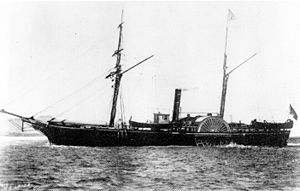 Shubrick Shubrick
| |
| History | |
|---|---|
| Name | Shubrick |
| Namesake | William Bradford Shubrick |
| Builder | Philadelphia Navy Yard, Pennsylvania, U.S. |
| Cost | $60,000 appropriation; $75,000 (reported) |
| Commissioned | 25 November 1857 (LHS) |
| Decommissioned | 23 August 1861 |
| Recommissioned | 15 October 1861 (RCS) |
| Decommissioned | 24 December 1866 |
| Recommissioned | 24 December 1866 (LHS) |
| Decommissioned | January 1886 |
| Fate | Sold, March 1886 |
| General characteristics | |
| Type | Lighthouse tender |
| Displacement | 305 long tons (310 t) |
| Length | 140 ft 8 in (42.88 m) |
| Beam | 22 ft 6 in (6.86 m) |
| Draft | 9 ft (2.7 m) |
| Propulsion |
|
| Speed |
|
| Armament |
|
USLHT Shubrick was the first lighthouse tender steamer constructed by the Lighthouse Board.
The ship was built at the Philadelphia Navy Yard of "Florida live oak and white oak," left over from the construction of the warship USS Wabash. She was "...topped by a flush deck fore and aft... To better withstand buoys scraping her sides, Shubrick's hull was painted black, topped with a white ribbon and waist. Red paddle wheels, white paddle boxes, and a black bowsprit, yards and gaffs added a saucy touch to her long and graceful cutwater, with six inches of bright copper shining above the waterline."
History
Lighthouse Board: 1857–1861
Completed on 25 November 1857, she was placed under the command of Captain T. A. Harris, and set sail for San Francisco, California, through the Strait of Magellan on 23 December 1857, arriving on 27 May 1858 after a voyage of 155 days. Shubrick spent the next three years setting buoys and carrying lighthouse supplies along the Pacific coast.
Revenue Cutter Service: 1861–1866
On 23 August 1861, on the outbreak of the Civil War, she was transferred to the Revenue Cutter Service. Commissioned on 15 October 1861 she served under Revenue Cutter Service orders for almost four years, performing customs and law enforcement duties, based first out of San Francisco, and then at Port Townsend from June 1862.
Port Townsend incident
In the early part of August 1862, Victor Smith, collector of customs, arrived to take possession of the customhouse at Port Townsend. The Pacific coast had been was alarmed by the advances of the Confederates in New Mexico and Arizona, their secret negotiations to secure the cooperation of the governments of Sonora and Chihuahua and the belief that their secret organizations were thought to be ready to attempt the seizure of the West coast. For these reasons Lieutenant James H. Merryman, acting collector, fearing this was such an attempt declined to turn over the property unless presented with his papers of authorization. The customs collector declined to furnish them but went to Shubrick, selected an armed guard, returned and demanded the customhouse be given up in fifteen minutes or it would be taken by force.
Lieutenant Merryman instead turned over the customhouse and papers to Lieutenant Wilson of Shubrick, who gave him a receipt for the papers and placed them on board. A threatening attitude was assumed by the cutter, her guns were trained upon the port. On 11 August, a warrant was issued for the arrest of Lieutenant Wilson and Victor Smith, but when the United States Marshal boarded Shubrick on her return trip, Lieutenant Wilson refused to obey the warrant and sailed away. A month later the issue was resolved when both Smith and Wilson agreed to undergo an investigation.
Remaining service of USS Shubrick
On 15 February 1865, Shubrick was transferred to the Navy Department for 90 days for special service in the Bering Strait supporting survey operations conducted by a Colonel Charles S. Buckley, the agent of the Russian Telegraph Company. She then returned to San Francisco, and the Revenue Cutter Service, who in turn handed her back to the Lighthouse Board on 24 December 1866.
Lighthouse Board: 1867–1886
On 8 September 1867, while transporting building materials to the Cape Mendocino Lighthouse, Shubrick ran aground 30 miles south of the site. Considered a total loss, she was abandoned, but her chief engineer, Thomas Winship, was able to save her. Shubrick was rebuilt at the San Francisco Navy Yard at a cost of $162,399.12 and was placed back in service in 1869. She transferred to the 13th Lighthouse District in January 1880, and remained active for five more years, before being taken out of service in December 1885, and decommissioned the following month.
She was sold at Astoria, Oregon in March 1886. Her new owner ran her aground and stripped her of usable material, and then burnt her hull to recover all of her copper and metal fittings.
See also
References
- "U.S. Coast Guard Cutter History". uscg.mil. Retrieved 9 November 2009.
- "Lighthouse Tenders of the United States". National Park Service. Retrieved 6 January 2008.
- White, Jr., Richard D. (1976). "Saga of the Side-Wheel Steamer Shubrick: Pioneer Lighthouse Tender of the Pacific Coast". American Neptune. XXCVI (1): 47.
- Aurora Hunt, The Army of the Pacific; Its operations in California, Texas, Arizona, New Mexico, Utah, Nevada, Oregon, Washington, plains region, Mexico, etc. 1860–1866, under the chapter The Pacific Squadron of 1861–1866. pp.303–304.
 This article incorporates text from the public domain Dictionary of American Naval Fighting Ships. The entry can be found here.
This article incorporates text from the public domain Dictionary of American Naval Fighting Ships. The entry can be found here.
External links
- uscg.mil/history/: Shubrick, 1857
- The Coast Guard in the Pacific Northwest by Dennis L. Noble
- William Cooke Pease Collection, 1838–1906
- 1863 news account of Shubrick Conspiracy